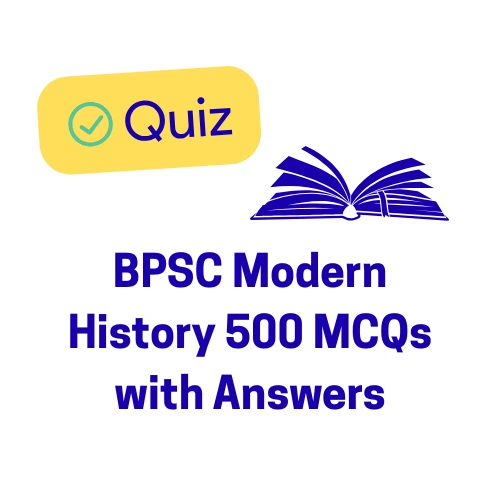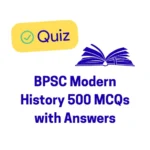BPSC Modern History Part 11 (500 MCQs) focus on the Swarajists, Revolutionary Activities (1920s), Simon Commission, Nehru Report, and the Civil Disobedience Movement (1923-1934).
BPSC Modern History Part 11 (500 MCQs)
Section AA: Swarajists and Revolutionary Activities (1923-1929)
Q301. The Swaraj Party was formed in 1923 by which leaders who advocated for ‘Council Entry’ (entry into the legislative councils)?
(A) Motilal Nehru and Jawaharlal Nehru
(B) C. R. Das and Motilal Nehru
(C) Sardar Vallabhbhai Patel and Rajendra Prasad
(D) Lala Lajpat Rai and Bipin Chandra Pal
Q302. Who was the first President of the Swaraj Party?
(A) Motilal Nehru
(B) C. R. Das
(C) Vithalbhai Patel
(D) Hakeem Ajmal Khan
Q303. The Swarajists’ main objective upon entering the legislative councils was:
(A) To cooperate with the British government to pass beneficial legislation.
(B) To secure constitutional reform through continuous obstruction of government business.
(C) To form a coalition government with the Moderates.
(D) To achieve complete independence immediately.
Q304. The Hindustan Republican Association (HRA) was founded in 1924 to organize revolutionary activities. Its prominent members included:
(A) Sachindra Nath Sanyal and Ram Prasad Bismil
(B) Bhagat Singh and Sukhdev
(C) Chandrashekhar Azad and Jatin Das
(D) More than one of the above
Q305. The famous Kakori Conspiracy Case (1925), involving the train robbery of government funds, was orchestrated by which revolutionary organization?
(A) Ghadar Party
(B) Anushilan Samiti
(C) Hindustan Republican Association (HRA)
(D) Abhinav Bharat Society
BPSC Modern History Part 11 (500 MCQs)
Q306. The HRA was reorganized as the Hindustan Socialist Republican Association (HSRA) in 1928 at Feroz Shah Kotla Ground in Delhi under the leadership of:
(A) Bhagat Singh
(B) Chandrashekhar Azad
(C) Sukhdev
(D) Rajguru
Q307. Bhagat Singh, Sukhdev, and Rajguru were associated with the assassination of which British police officer in Lahore (1928) in retaliation for the death of Lala Lajpat Rai?
(A) Saunders (Assistant Superintendent of Police)
(B) General Dyer
(C) Sir Michael O’Dwyer
(D) Rand
Q308. Which two revolutionaries threw a bomb in the Central Legislative Assembly in Delhi in 1929 to protest the Public Safety Bill and Trade Disputes Bill?
(A) Bhagat Singh and Sukhdev
(B) Bhagat Singh and Batukeshwar Dutt
(C) Chandrashekhar Azad and Rajguru
(D) Jatin Das and Shivaram Rajguru
Q309. Who led the Chittagong Armory Raid (1930) and was famously known as ‘Masterda’?
(A) Surya Sen
(B) Pritilata Waddedar
(C) Kalpana Dutt
(D) Hemchandra Kanungo
Q310. The longest hunger strike by a revolutionary prisoner to protest against the inhumane conditions of Indian political prisoners was observed by:
(A) Bhagat Singh
(B) Jatin Das (63 days)
(C) Sukhdev
(D) Chandrashekhar Azad
Section BB: Simon Commission and Nehru Report
Q311. The Simon Commission was appointed in 1927 to review the working of which constitutional act?
(A) Government of India Act, 1909
(B) Government of India Act, 1919
(C) Indian Councils Act, 1892
(D) Charter Act of 1853
Q312. The Simon Commission was boycotted by Indian nationalists because:
(A) It proposed Purna Swaraj instead of Dominion Status.
(B) It did not include any Indian member in its composition.
(C) It was formed prematurely before the stipulated time.
(D) All of the above
Q313. The slogan ‘Simon Go Back’ was raised during the anti-Simon Commission protests. The slogan was most likely coined by:
(A) Mahatma Gandhi
(B) Jawaharlal Nehru
(C) Yusuf Meherally
(D) Lala Lajpat Rai
Q314. Which nationalist leader succumbed to injuries received during a police lathi-charge while protesting the Simon Commission in Lahore?
(A) Bhagat Singh
(B) Lala Lajpat Rai
(C) Bipin Chandra Pal
(D) G. K. Gokhale
Q315. In response to Lord Birkenhead’s challenge to Indians to draft a consensus constitution, the Congress convened an All Parties Conference and drafted the:
(A) Cripps Proposal
(B) August Offer
(C) Nehru Report
(D) Cabinet Mission Plan
BPSC Modern History Part 11 (500 MCQs)
Q316. The Nehru Report (1928), drafted by a committee headed by Motilal Nehru, primarily demanded which of the following?
(A) Complete Independence (Purna Swaraj)
(B) Dominion Status on the lines of Canada or Australia
(C) Separate electorates for all minorities
(D) Abolition of the Princely States
Q317. Which prominent leader was strongly opposed to the Nehru Report’s recommendation for Dominion Status and instead pushed for Complete Independence?
(A) Motilal Nehru
(B) Mahatma Gandhi
(C) Jawaharlal Nehru (and Subhas Chandra Bose)
(D) C. R. Das
Q318. Which important national leader rejected the Nehru Report and put forward his own ‘Fourteen Points’ as an alternative set of demands?
(A) Maulana Abul Kalam Azad
(B) Dr. B. R. Ambedkar
(C) Muhammad Ali Jinnah
(D) Shaukat Ali
Q319. The Calcutta Session of the INC (1928) gave the British Government a deadline to accept the Nehru Report. If not accepted, the Congress threatened to launch a movement for:
(A) Dominion Status
(B) Purna Swaraj
(C) Diarchy
(D) Responsible Government
Q320. Which Viceroy announced the ‘Deepavali Declaration’ in 1929, vaguely assuring that the constitutional goal of India was the attainment of Dominion Status?
(A) Lord Reading
(B) Lord Irwin
(C) Lord Linlithgow
(D) Lord Wavell
Section CC: Civil Disobedience Movement (1930-1934)
Q321. In which session did the Indian National Congress declare Purna Swaraj (Complete Independence) as its ultimate goal?
(A) Calcutta Session, 1928
(B) Lahore Session, 1929
(C) Karachi Session, 1931
(D) Lucknow Session, 1936
Q322. The first Independence Day (Purna Swaraj Day) was celebrated across India on:
(A) January 26, 1930
(B) August 15, 1930
(C) December 31, 1929
(D) March 12, 1930
Q323. The Civil Disobedience Movement was launched by Mahatma Gandhi after his famous Eleven Demands were rejected by the Viceroy. This movement began with the:
(A) Chauri Chaura Incident
(B) Dandi March (Salt Satyagraha)
(C) Individual Satyagraha
(D) Quit India Movement
Q324. Mahatma Gandhi started the Dandi March from which place?
(A) Dandi (coastal Gujarat)
(B) Sabarmati Ashram (Ahmedabad)
(C) Wardha Ashram
(D) Champaran
Q325. In Tamil Nadu, the Salt Satyagraha was led by which leader, marching from Tiruchirappalli to Vedaranyam?
(A) C. Rajagopalachari (Rajaji)
(B) K. Kamaraj
(C) P. S. Kumaraswamy Raja
(D) T. Prakasam
BPSC Modern History Part 11 (500 MCQs)
Q326. Who was the leader who led the agitation in the North-West Frontier Province (NWFP) during the Civil Disobedience Movement and was famously known as the ‘Frontier Gandhi’?
(A) Abdul Gaffar Khan
(B) Maulana Abul Kalam Azad
(C) Shaukat Ali
(D) Khan Abdul Jabbar Khan
Q327. The movement of the ‘Red Shirts’ (Khudai Khidmatgars) under Khan Abdul Gaffar Khan was significant because it emphasized:
(A) Violent overthrow of the British.
(B) Non-violent methods in a predominantly Muslim and tribal area.
(C) Armed rebellion for an independent Pashtunistan.
(D) Cooperation with the British government.
Q328. The first Round Table Conference (1930) in London was boycotted by the INC. Which prominent leader was not a participant in the First Round Table Conference?
(A) Dr. B. R. Ambedkar
(B) Tej Bahadur Sapru
(C) Muhammad Ali Jinnah
(D) Mahatma Gandhi
Q329. The Gandhi-Irwin Pact (1931) led to the suspension of the Civil Disobedience Movement. The pact included which of the following provision(s)?
Immediate release of all political prisoners not convicted of violence
Participation of the INC in the Second Round Table Conference.
Right to manufacture and sell salt in coastal villages.
(A) 1 and 2 only
(B) 2 and 3 only
(C) 1 and 3 only
(D) 1, 2, and 3
Q330. Who was the sole representative of the Indian National Congress at the Second Round Table Conference in London (1931)?
(A) Jawaharlal Nehru
(B) Sardar Vallabhbhai Patel
(C) Mahatma Gandhi
(D) Sarojini Naidu

